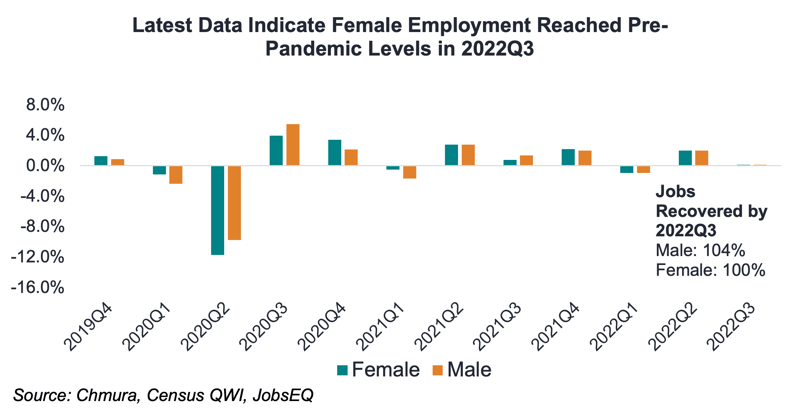A lot has changed since our first blog on this topic in late 2021, and newly released data shed additional light on the initial impact of the COVID-19 pandemic on female employment and its continued effects.
Women in the workforce faced steeper job losses than men at the start of the pandemic, and those jobs have been recovering more slowly than for men across the nation. As of the third quarter of 2022, female employment is estimated to have recovered 100% of jobs lost at the national level.
Data from the Quarterly Workforce Indicators series from the Bureau of Labor Statistics and Chmura’s JobsEQ indicate that between the fourth quarter of 2019 and the second quarter of 2020, the number of women employed fell 12.7%, compared with a decline of 11.9% for men. As of the third quarter of 2022, female employment has recovered an estimated 100% of jobs lost, four percentage points below the 104% recovered by men.

Despite the national recovery, there is significant regional variation in female employment trends. The interactive maps below summarize statewide impacts and recovery by gender.[1] With the latest data revisions, the largest differences in job losses by gender were in Mississippi and Arkansas, as a greater share of women lost jobs in hard-hit industries such as retail trade; healthcare; and arts, entertainment, and recreation. In the Northeast, specifically New Hampshire, New Jersey, Vermont, and Maine, strict and rapid shutdowns limited in-person jobs and women also lost a greater share of jobs in industries like manufacturing and transportation and warehousing that were more resilient in other states.
In terms of recovery, women in Wyoming, North Dakota, Oklahoma, and Texas experienced fewer impacts due to pandemic shutdowns and employment has recovered much faster than for men. In particular, continued growth in jobs held by women in professional, scientific and technical services and real estate and rental and leasing have boosted overall female employment job recovery relative to men. Female employment has not recovered to pre-pandemic levels or only just recovered in several states. In states as widespread as New York, Louisiana, Kansas, Vermont, and Maryland, total employment remains below pre-pandemic levels for women and for men as of 2022Q3.
With signs of a potential recession looming, states and industries that still have not recovered may face further setbacks this year. Localities and employers should consider this disparity while developing strategies to assist women who want to return to work and encourage those not in the labor force to rejoin.
---------------------------------
[1] Participation in QWI data collection is up to individual states, and the latest data available varies. Alaska data are through 2016Q2, while Arkansas and Mississippi are through 2018Q2. Chmura used national trends to bring these state estimates forward. All others are updated through 2020Q3, with preliminary estimates through 2021Q2 by Chmura. As in the national data analysis, unclassified sector data are excluded.